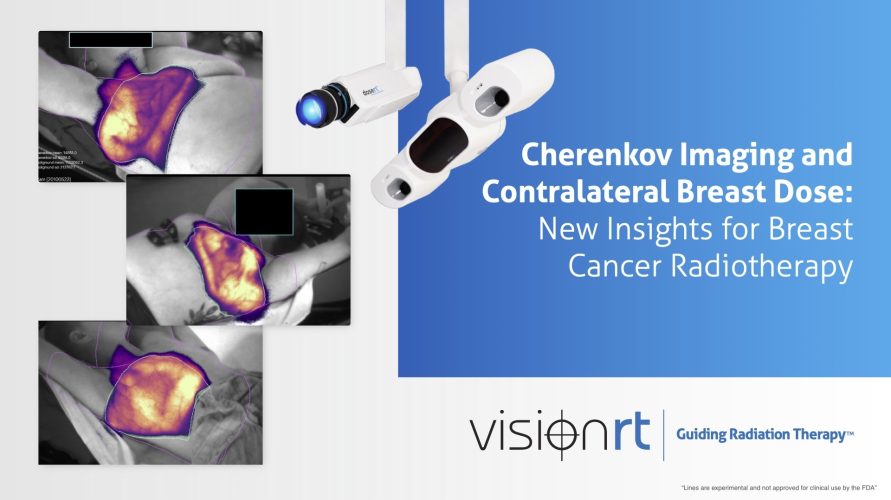Cherenkov Imaging and Contralateral Breast Dose: New Insights for Breast Cancer Radiotherapy

As we mark Breast Cancer Awareness Month, we’re often reminded of the importance of not just treating cancer effectively but also doing so with precision and minimizing risk to healthy tissue. One area of increasing interest is contralateral breast dose – radiation delivered unintentionally to the breast opposite the one being treated. To explore new ways this is being measured and managed, we interviewed Dr. Allison Matous, MD, Dartmouth Cancer Center, about her recent research using Cherenkov imaging.
What is Cherenkov Imaging?
Dr. Matous explains:
“Cherenkov imaging allows us to visualize radiotherapy beams in real-time as they interact with the patient.”
This technique is based on the Cherenkov effect, where charged particles moving faster than the speed of light in tissue emit a faint blue glow. Specialized cameras capture this light, allowing radiation delivery to be observed directly on the patient’s surface.
For radiation therapists, this means what was once invisible during treatment can now be monitored in real-time, improving both accuracy and safety.
What Did the Trial Investigate, and Why Does Contralateral Breast Dose Matter?
“Cherenkov imaging allows us to confirm the accuracy of treatment, but it’s also revealed instances where we’re seeing unintended sites exposed to radiation. Contralateral breast dose may be small, but it isn’t insignificant,” says Dr. Matous.
Research from the WECARE study highlights that levels of exposure in excess of 1 Gy in younger patients are linked to an elevated risk of developing contralateral breast cancer1.
“Seeing dose spill into the contralateral breast in our imaging really sparked the question – what is the actual dose going over there, and should we be worried about it? The breast is a radiosensitive organ, especially in younger patients. Since we’re treating younger and younger women who have excellent prognoses and many decades ahead of them, minimising contralateral breast dose is essential.”
Data shows that between 2012 and 2021, breast cancer incidence increased by 1.4% annually among women under 50, outpacing the 0.7% annual rise observed in women aged 50 and older2.
Key Findings from the Study
Dr. Matous shared insights from the EDUCATE trial, which began in October 2024:
“The trial is still ongoing, but so far, we systematically reviewed Cherenkov images from more than 200 patients. We found that over 40% of patients showed some degree of contralateral breast dose. With complex approaches like wide tangents, aPBI with VMAT, and chest wall with VMAT, nearly all patients showed some contralateral exposure. About 10% of contralateral breast dose exposures we observed were unplanned and unexpected. That’s a surprisingly high number and importantly, it’s something we can act on during treatment.
Across our three sites, we treat roughly 300 breast patients a year. So even a small percentage of unplanned dose exposure affects a significant number of people.”
Implications for Clinical Practice
“For therapists, Cherenkov imaging provides immediate feedback. You’re not just assuming what the contralateral dose might be, you can actually see it during treatment. This has implications for setup, in vivo dosimetry placement, and patient safety overall. In the long run, I think this technology could help departments refine planning and delivery techniques to minimize contralateral exposure even further.”
Looking Ahead
“This is still early work, but it opens up new possibilities. Cherenkov imaging and scintillation dosimetry give us tools to better understand radiation delivery as it happens. Even beyond contralateral breast dose, Cherenkov imaging reveals setup issues and opportunities to adjust patient positioning, helping us deliver more idealized treatments. Ultimately, that means we can continue to improve both the safety and the quality of breast radiotherapy.”
- Reiner, Anne S., et al. “Breast Cancer Family History and Contralateral Breast Cancer Risk in Young Women: An Update from the Women’s Environmental Cancer and Radiation Epidemiology Study.” Journal of Clinical Oncology, vol. 36, no. 15, 20 May 2018, pp. 1
- Giaquinto AN, Sung H, Newman LA, Freedman RA, Smith RA, Star J, Jemal A, Siegel RL. Breast cancer statistics 2024. CA Cancer J Clin. 2024 Nov-Dec;74(6):477-495. doi: 10.3322/caac.21863. Epub 2024 Oct 1. PMID: 39352042.
Get in touch
Ready to take the next step?
Vision RT’s family of SGRT solutions guide radiation therapy for better patient care at every step: Sim, Planning, Treatment and Dose. Whether you’re looking for a quote, a product demo (virtual or in-person) or just more information, please get in touch.